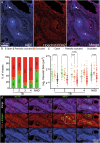Neutrophil extracellular traps characterize caseating granulomas
- PMID: 39085192
- PMCID: PMC11291884
- DOI: 10.1038/s41419-024-06892-3
Neutrophil extracellular traps characterize caseating granulomas
Abstract
Tuberculosis (TB) remains one of the top 10 causes of death worldwide and still poses a serious challenge to public health. Recent attention to neutrophils has uncovered unexplored areas demanding further investigation. Therefore, the aim of this study was to determine neutrophil activation and circulatory neutrophil extracellular trap (NET) formation in various types of TB. Sera from TB patients (n = 91) and healthy controls (NHD; n = 38) were analyzed for NE-DNA and MPO-DNA complexes, cell-free DNA (cfDNA), and protease activity (elastase). We show that these NET parameters were increased in TB sera. Importantly, NET formation and NE activity were elevated in TB patients with extensive tissue damage when compared to those with minor damage and in patients with relapse, compared to new cases. We discuss the importance of balancing NET formation to prevent tissue damage or even relapse and argue to analyze circulating NET parameters to monitor the risk of disease relapse. To investigate the tissues for NETs and to find the source of the circulating NET degradation products, we collected sections of granulomas in lung and lymph node biopsies. Samples from other diseases with granulomas, including sarcoidosis (SARC) and apical periodontitis (AP), served as controls. Whereas NET formation characterizes the caseating granulomas, both caseating and non-caseating granulomas harbor DNA with unusual conformation. As TB is associated with hypercoagulation and thromboembolism, we further imaged the pulmonary vessels of TB patients and detected vascular occlusions with neutrophil aggregates. This highlights the dual role of neutrophils in the pathology of TB.
© 2024. The Author(s).
Conflict of interest statement
The authors declare no competing interests.
Figures







References
MeSH terms
Substances
Grants and funding
- 202006370030/China Scholarship Council (CSC)
- Grant 97744/Volkswagen Foundation (VolkswagenStiftung)
- Grant 97744/Volkswagen Foundation (VolkswagenStiftung)
- 2886 PANDORA Project-No. B3/Deutsche Forschungsgemeinschaft (German Research Foundation)
- CRC1181-261193037 (C03)/Deutsche Forschungsgemeinschaft (German Research Foundation)
LinkOut - more resources
Full Text Sources
Research Materials
Miscellaneous

